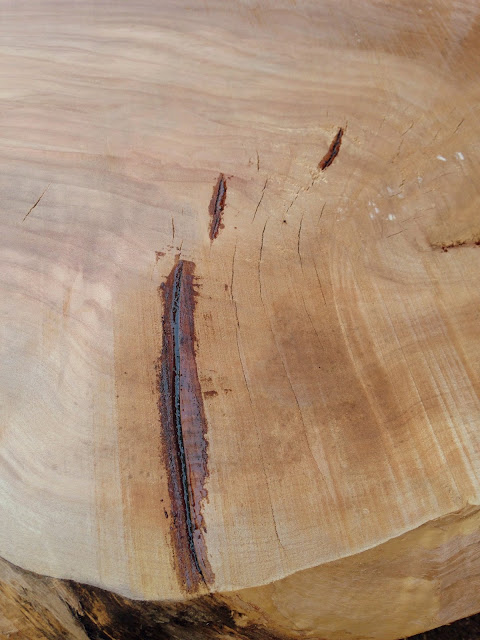
I was excited to find the sewing machine base in a local thrift store. Even though it was chipped and rusty in some spots, I decided against painting it. I did polish it with some paste wax and then lightly sprayed it with a clear coat.
The live edge slab was milled locally. Even though I knew it would be a lot of work to sand it smooth, I definitely underestimated how much work it would take, especially with my little finishing sander. I really should have invested in a planer or belt sander! I started with 60 grit and sanded up to 220. The last pass was with a sanding pad that resembled those green scrubby pads for dishes, but softer. It was recommended to me by the staff at my local Woodcraft. I think they are usually used to polish turned wood.
Before sanding the slab, I also filled the cracks and any pits with a 5 minute epoxy mixed with finely ground coffee. The epoxy-coffee mixture is much darker than the wood, but I thought it would look great with the black base. Applying it is a bit scary, but it sands down very well.
 |
| The coffee-epoxy mixture applied to the cracks. |
 |
| The epoxy filled cracks sanded smooth. |
To finish the slab, I applied 2 coats of boiled walnut oil which brought out the grain, followed by a polish with the pad. I decided I wanted to try using shellac to finish the table. I hadn't worked with shellac before, and while I liked it, it was definitely challenging to work with. I made a 1 lb cut and first applied it with a brush. It came out awful! The edges of each pass of the brush dried into ripples and looked so silly. Unlike an oil-based polyurethane that will self level, so brush strokes won't show, shellac is alcohol-based and dries within minutes so technique was really important. The nice part about shellac, though, is that mistakes can be removed with denatured alcohol, versus polyurethane that usually needs a chemical stripper.
After buffing out the uneven ripples with an alcohol soaked pad, I switched to applying the shellac with a cloth. It took many more coats than if I'd used a brush to build up that glassy finish, but I'm happier with the results. After each coat, I polished with the pad.
Even though this table was a lot of work (my shoulders are still sore as I write this!), I love the funkiness of the slab, the asymmetry on the base, and the age of the sewing base.





































